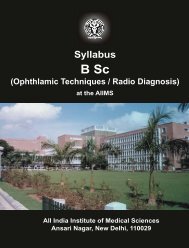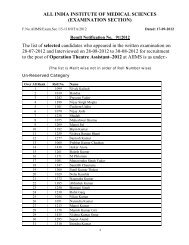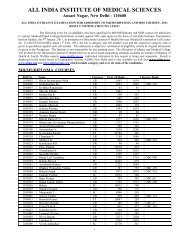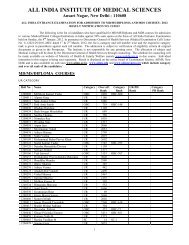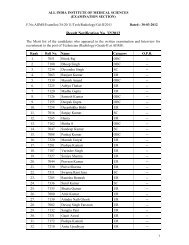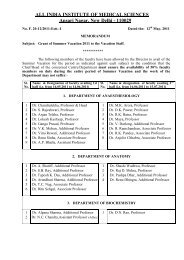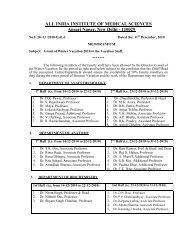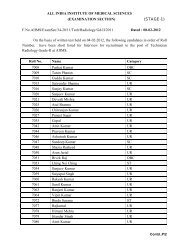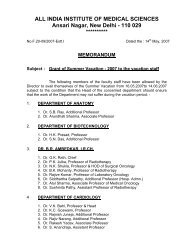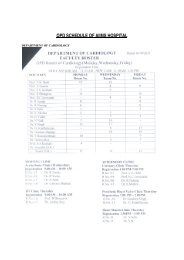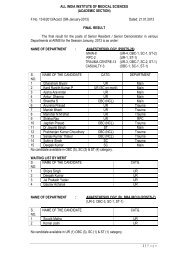Manual for long-term pharmacotherapy - All India Institute of Medical ...
Manual for long-term pharmacotherapy - All India Institute of Medical ...
Manual for long-term pharmacotherapy - All India Institute of Medical ...
You also want an ePaper? Increase the reach of your titles
YUMPU automatically turns print PDFs into web optimized ePapers that Google loves.
Introduction<br />
Long-Term Use <strong>of</strong> Naltrexone For Opiate Dependence<br />
Sonali Jhanjee* and Indra Mohan**<br />
Opioid dependence causes several familial, occupational, social and medical complications among dependent<br />
individuals and their families. One <strong>of</strong> the treatment options available to treat such individuals is the use <strong>of</strong><br />
maintenance medication (substitution with an orally active opioid drug,like methadone and buprenorphine),<br />
which has proven to be the most effective treatment <strong>for</strong> opioid dependence.However, opiate antagonists like<br />
naltrexone <strong>of</strong>fer a treatment approach that is distinctly different from that <strong>of</strong> agonist maintainence. These<br />
opiate antagonists have been used <strong>for</strong> some time as antidotes after opiate overdosage, but their application in<br />
the treatment <strong>of</strong> opioid dependence is more recent.<br />
Opiate antagonists are substances that bind to the opiate receptors but do not produce morphine like effects.<br />
The first clinically useful antagonist was nalorphine, which reduced morphine effects, but also produced some<br />
agonist effects. Because <strong>of</strong> it's potential <strong>for</strong> increasing rather than decreasing respiratory depression,<br />
nalorphine has been replaced by naloxone as an antidote <strong>for</strong> opioid overdosage. Naloxone and naltrexone are<br />
relatively pure antagonists in that they produce little or no agonist activity at usual doses. Naloxone however<br />
has limited utility as a maintainence agent because it is poorly absorbed and has a duration <strong>of</strong> only a few hours<br />
following oral administration. Among the opiate antagonists, naltrexone, which became available <strong>for</strong> general<br />
use in 1985, has emerged as the most extensively studied agent to prevent relapse in opiate dependent patients.<br />
Naltrexone is an orally active and <strong>long</strong> acting potent pure narcotic antagonist.<br />
Structure<br />
Naltrexone was developed by substituting an N-methyl group on the opiate agonist oxymorphone with a<br />
methylcyclopropyl moiety.<br />
Pharmacokinetics<br />
Naltrexone is rapidly and completely absorbed following oral administration and reaches peak plasma<br />
concentration within an hour. It has high first pass metabolism and oral bioavailability is 60%, with 20% <strong>of</strong> the<br />
drug being bound to plasma proteins.<br />
Naltrexone undergoes first-pass metabolism in the liver via glucuornic acid conjugation with trans<strong>for</strong>mation<br />
to the active metabolite 6-beta naltrexol. The half-life <strong>of</strong> this drug is about 4 hours and that <strong>of</strong> its active<br />
metabolite is 10-12 hours.<br />
* Assistant Pr<strong>of</strong>essor, National Drug Dependence Treatment Centre, <strong>All</strong> <strong>India</strong> <strong>Institute</strong> <strong>of</strong> <strong>Medical</strong> Sciences<br />
**Senior Resident, National Drug Dependence Treatment Centre, <strong>All</strong> <strong>India</strong> <strong>Institute</strong> <strong>of</strong> <strong>Medical</strong> Sciences<br />
38




